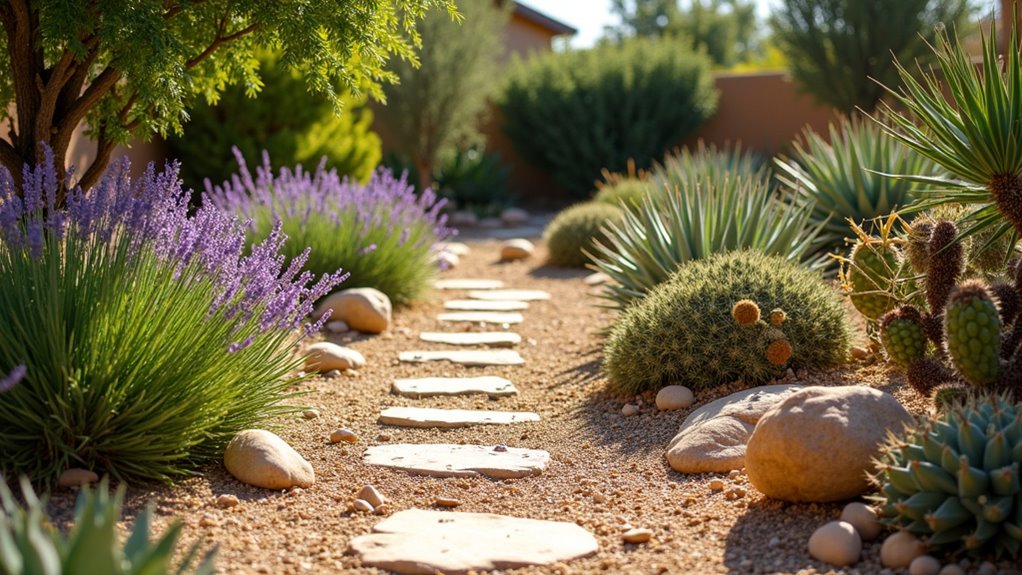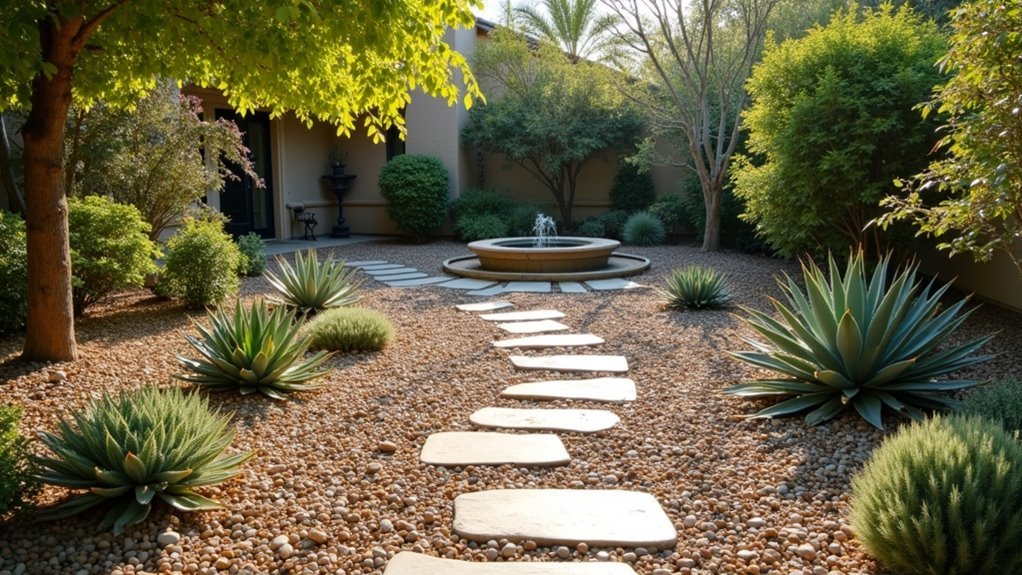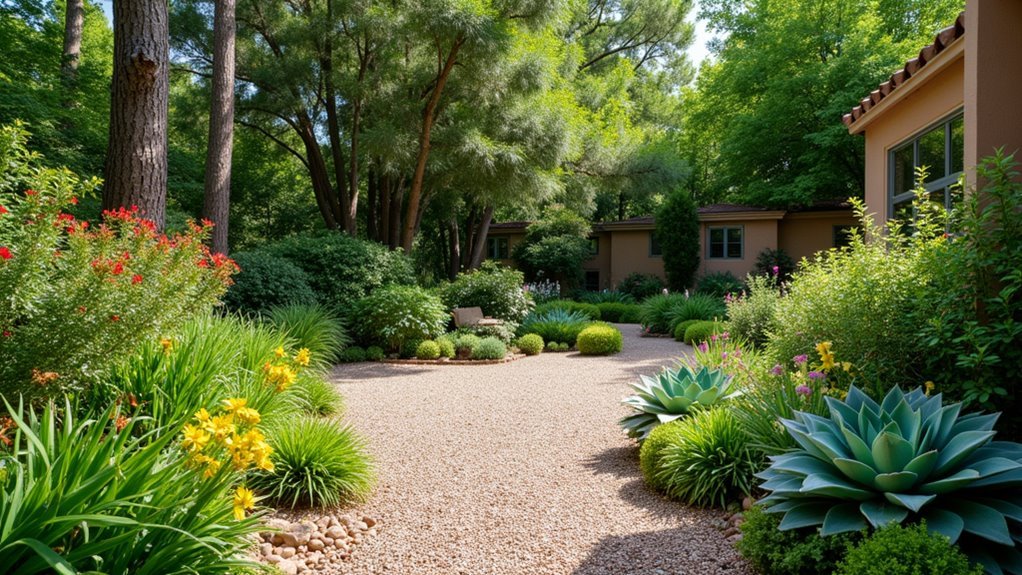You can create a scorpion-resistant yard by replacing organic mulch with gravel, planting deterrent species like lavender and marigolds, and installing LED pathway lighting to eliminate dark hiding spots. Focus on drought-resistant plants that thrive in arid conditions while avoiding citrus trees that attract pests. Design gap-free foundations using concrete barriers, elevate storage areas, and maintain proper drainage to prevent moisture buildup. These strategic landscape modifications will help you discover extensive protection methods.
Plant Selection Strategies for Natural Scorpion Deterrence

While scorpions can be formidable yard invaders, you can naturally discourage their presence through strategic plant selection.
Plant selection strategies for natural scorpion deterrence center around choosing species with strong, repellent scents. Lavender, lemongrass, marigolds, and mint all produce powerful fragrances that scorpions find offensive, creating an effective natural barrier around your property.
You’ll also want to focus on drought-resistant plants that maintain dry conditions throughout your landscape. Since scorpions love moist environments, reducing water retention helps eliminate their preferred habitats.
Avoid citrus trees whenever possible, as their rotting fruit and shade create attractive conditions for these arachnids. Instead, prioritize plants that thrive in arid conditions while producing natural deterrent compounds through their foliage and flowers.
Strategic Lighting Placement to Eliminate Dark Hiding Spots
Since scorpions prefer dark, sheltered spaces during daylight hours, strategic lighting placement becomes your most powerful tool for eliminating their preferred hiding spots.
Strategic lighting eliminates scorpions’ preferred dark hiding spots, making this your most powerful weapon against these nocturnal invaders.
You’ll want to focus on illuminating areas where scorpions typically seek refuge, making these nocturnal creatures uncomfortable and visible. Motion-sensor lights work exceptionally well because they disrupt scorpions’ natural habitat when they’re most active.
Here’s how to implement effective strategic lighting placement:
- Install pathway lighting along walkways, patios, and entry points to maintain consistent illumination.
- Use LED fixtures for energy-efficient, long-lasting light sources that won’t increase electricity costs.
- Position motion-activated lights in dark corners, under decks, and near landscaping features.
- Conduct regular maintenance checks to verify no burnt-out bulbs create new dark hiding spots.
Proper Drainage Systems to Prevent Moisture Accumulation

Beyond eliminating dark hiding spots with strategic lighting, you must address the moisture conditions that draw scorpions to your property in the first place. Proper drainage systems are essential for preventing moisture accumulation that attracts scorpions and their insect prey.
Start by ensuring your gutters and downspouts direct water away from your foundation while keeping them debris-free for effective flow.
Install French drains or dry wells where water pools to divert excess moisture from your landscaping and home.
Regularly inspect sprinkler systems to prevent leaks and overwatering that create damp environments scorpions prefer.
Implement grading techniques that slope away from structures, ensuring water flows away rather than accumulating near your foundation where scorpions might establish hiding spots.
Ground Cover Alternatives That Discourage Scorpion Habitation
You’ll want to replace traditional organic mulch with materials that won’t attract scorpions to your yard.
Gravel creates an inhospitable environment for these pests while low-growing succulents offer natural deterrence without providing hiding spots.
Concrete and stone surfaces eliminate moisture retention and shelter opportunities that scorpions typically seek.
Gravel Over Organic Mulch
One of the most effective ground cover swaps you can make involves replacing organic mulch with gravel throughout your landscaping.
Organic mulch retains moisture and creates perfect hiding spots that scorpions love, while gravel provides a dry, inhospitable environment they’ll avoid.
Here’s why gravel outperforms organic mulch for scorpion prevention:
- Eliminates moisture retention – Gravel doesn’t hold water like wood chips or bark, creating conditions scorpions find unappealing.
- Reduces insect populations – Less organic matter means fewer bugs for scorpions to hunt.
- Prevents effective burrowing – The loose, shifting surface makes it difficult for scorpions to establish hiding spots.
- Requires minimal maintenance – You won’t need frequent replacements that create debris accumulation.
Gravel also improves drainage, eliminating standing water that attracts both prey insects and scorpions themselves.
Low-Growing Succulent Options
While gravel creates an excellent foundation for scorpion deterrence, incorporating low-growing succulents takes your defense strategy even further by eliminating the gaps and spaces scorpions exploit for shelter.
These plants create dense ground cover that limits hiding spots while maintaining the dry conditions scorpions dislike.
Choose sedums and creeping thyme to establish thick coverage that denies scorpions access to soil-level shelter.
Stonecrop varieties thrive in well-drained conditions, helping maintain the moisture-free environment you’re targeting.
Dwarf ice plants eliminate shaded areas scorpions prefer for daytime hiding while adding vibrant color to your landscape.
Low-growing succulents like agave and aloe produce minimal leaf litter, removing potential shelter materials.
Since these plants require less water than traditional landscaping, you’ll reduce moisture levels that attract scorpions and their insect prey.
Concrete and Stone Surfaces
Concrete and stone surfaces form an impenetrable barrier that scorpions can’t easily navigate or exploit for shelter. These hard materials create an unwelcoming environment that forces scorpions to seek refuge elsewhere.
Unlike organic ground covers, concrete and stone surfaces eliminate the dark, moist hiding spots scorpions desperately need.
Strategic implementation of these materials includes:
- Installing gravel or decorative stone in landscaped areas to replace mulch and organic debris
- Creating smooth patios and walkways that scorpions struggle to traverse effectively
- Building concrete borders and retaining walls to establish defined, inhospitable zones
- Maintaining proper drainage and debris removal to prevent moisture accumulation around these surfaces
You’ll find that incorporating concrete and stone surfaces into your landscape design greatly reduces scorpion populations while enhancing your yard’s visual appeal.
Hardscape Design Elements That Block Scorpion Access
You’ll want to focus on three key hardscape strategies to prevent scorpions from accessing your property and finding shelter.
Strategic barrier placement using retaining walls and gravel borders creates physical obstacles that deter scorpion movement, while gap-free foundation design eliminates entry points around your home’s perimeter.
Elevated material storage keeps potential hiding spots off the ground and away from areas where scorpions typically seek shelter.
Strategic Barrier Placement
As scorpions navigate through your yard searching for shelter and prey, strategic hardscape placement can effectively block their pathways to your home.
You’ll need to position barriers thoughtfully around your property’s perimeter to maximize protection.
Strategic barrier placement involves creating multiple defensive layers:
- Foundation perimeter – Install stone pathways or gravel beds directly adjacent to your home’s foundation to eliminate hiding spots.
- Retaining walls – Position raised structures to create elevated zones that scorpions can’t easily traverse.
- Solid surface connections – Replace mulch areas with pavers or concrete slabs near entry points.
- Diatomaceous earth borders – Apply this natural deterrent around hardscape features to reinforce your barriers.
Minimize gaps between these elements to prevent scorpions from finding entry points into your outdoor spaces.
Gap-Free Foundation Design
While strategic barriers form your yard’s outer defenses, creating a gap-free foundation design serves as your home’s final line of protection against scorpion intrusion.
You’ll need to construct a solid barrier using concrete or stone materials that completely eliminates cracks and openings these pests exploit.
Install a perimeter of tightly fitted pavers or stones directly around your foundation to block potential entry points. Consider adding a continuous concrete curb or footer for enhanced protection, especially if you live in scorpion-prone areas.
Incorporate gravel landscaping around your foundation since it creates an inhospitable environment where scorpions can’t hide.
Don’t forget regular inspection and maintenance—promptly seal any new cracks or gaps to maintain your scorpion-proof design’s integrity.
Elevated Material Storage
Elevation transforms your yard storage from scorpion havens into inaccessible barriers.
You’ll drastically reduce scorpion shelter options by implementing elevated storage solutions throughout your property.
Effective elevated storage strategies include:
- Platform construction – Build wooden or metal platforms at least 18 inches high for firewood, construction supplies, and gardening equipment.
- Wall-mounted shelving – Install outdoor shelving systems that keep materials completely off ground level.
- Raised garden beds – Use elevated planters that eliminate ground contact where scorpions typically nest.
- Hardscape integration – Surround elevated storage with gravel or pavers to create inhospitable conditions.
Combining elevated storage with debris removal and moisture control maximizes your scorpion prevention efforts.
These platforms deny scorpions the dark, moist hiding spots they prefer while keeping your materials organized and accessible.
Tree and Shrub Pruning Techniques for Scorpion Prevention
Though scorpions seek dark, sheltered spaces to hide during daylight hours, you can greatly reduce their presence by implementing strategic pruning techniques throughout your landscape. Many scorpion species found in residential areas prefer overgrown vegetation that creates shaded hiding spots near homes.
| Pruning Task | Height/Action | Prevention Benefit |
|---|---|---|
| General shrubs/trees | Maximum 18 inches tall | Eliminates nesting habitats |
| Palm fronds | Remove dead/excess growth | Reduces shelter and moisture |
| Low branches | Cut branches touching ground | Prevents climbing access |
| Debris removal | Clear fallen materials regularly | Limits hiding spots and food sources |
You’ll need to trim palm tree fronds and remove dead bark that attracts moisture-seeking scorpions. Regular maintenance prevents accumulation of fallen leaves and branches that create ideal scorpion environments.
Essential Oil Applications in Landscape Design

Beyond physical modifications to your landscape, you can harness the power of natural scents to create an invisible barrier that scorpions find uninviting.
Essential oils offer a natural, effective solution for scorpion deterrence while enhancing your garden’s appeal.
Essential oils provide dual benefits: naturally repelling scorpions from your property while adding beautiful fragrances and visual interest to your outdoor spaces.
Here’s how to implement essential oils in your landscape design:
- Create protective sprays by mixing 20 drops of lavender or cedar essential oil with water, then apply around garden areas, windows, and entry points.
- Plant natural oil producers like lavender and mint directly in your landscape for continuous protection and visual appeal.
- Establish regular spray schedules around your yard’s perimeter and potential hiding spots, especially during warmer months.
- Check ASPCA guidelines before application to verify pet and wildlife safety.
Rock and Debris Removal for Scorpion-Proof Gardens
You’ll need to tackle the clutter in your yard that creates perfect scorpion hideouts.
Start by removing large rock piles, which offer cool, dark spaces that scorpions love for shelter during hot days.
Clear away any rotting wood debris, fallen logs, and lumber scraps since these materials provide both moisture and protection that attract scorpions to your property.
Remove Large Rock Piles
Since scorpions seek out dark, protected spaces during daylight hours, large rock piles scattered throughout your yard create perfect sanctuaries for these unwelcome visitors.
When you remove large rock piles from your property, you’re eliminating prime real estate that scorpions depend on for shelter and breeding. These rocky hideouts also attract insects that scorpions hunt, creating an entire ecosystem you don’t want near your home.
To effectively clear your yard of scorpion-friendly rock accumulations:
- Survey your entire property for scattered rock collections, including decorative stone features.
- Relocate rocks far from your home rather than simply redistributing them nearby.
- Clear organic debris that’s accumulated around rock piles to eliminate insect food sources.
- Maintain regular inspection schedules to prevent new rock accumulations from forming.
Clear Rotting Wood Debris
Rotting wood debris transforms your yard into a scorpion magnet by creating the perfect storm of shelter and food sources.
Decaying logs and stumps provide ideal hiding spots while attracting insects that scorpions hunt. You’ll need to regularly inspect your property for any decomposing wood materials and remove them immediately.
When you clear rotting wood debris, pay special attention to forgotten log piles, old tree stumps, and abandoned wooden structures.
Store firewood and construction materials off the ground and away from your home’s foundation. Don’t let organic debris like fallen branches accumulate in your yard.
This proactive approach eliminates scorpion habitats while promoting healthier landscaping.
Barrier Installation Methods Around Property Perimeter
Multiple barrier installation methods can effectively protect your property perimeter from scorpion intrusion.
You’ll need to combine physical and natural deterrents to prevent scorpions from accessing your home and yard.
Here are four effective barrier installation methods:
- Diatomaceous earth perimeter – Create a continuous ring around your property using food-grade diatomaceous earth, which dehydrates scorpions upon contact.
- Strategic sticky trap placement – Position adhesive traps along fence lines and entry points to capture scorpions before they reach your home.
- Solid material fencing – Install physical barriers using concrete, metal, or dense materials that scorpions can’t easily climb.
- Natural deterrent application – Apply molasses and orange oil-infused compost tea mixture around boundaries for pet-safe protection.
Regularly inspect and seal any gaps or cracks to maintain barrier effectiveness.
Maintenance Schedules for Long-Term Scorpion Control
While installing effective barriers provides initial protection, maintaining them requires consistent attention to confirm scorpions don’t establish footholds on your property.
Your maintenance schedule should combine regular inspections with targeted actions. Weekly debris removal eliminates hiding spots and food sources that attract scorpions. Bi-weekly landscaping checks confirm overgrown vegetation doesn’t create shaded refuges.
| Frequency | Task | Focus Area |
|---|---|---|
| Weekly | Debris removal | Eliminate hiding spots |
| Bi-weekly | Trim vegetation | Reduce shaded areas |
| Monthly | Seal entry points | Foundation, doors, windows |
| Quarterly | Professional pest control | Target nesting areas |
Monthly foundation inspections help you seal cracks around doors and windows before scorpions enter. Seasonal water management prevents moisture buildup that draws prey insects. Quarterly professional pest control treatments specifically target scorpion nesting areas, confirming thorough long-term prevention throughout your property.
Frequently Asked Questions
What Landscaping Keeps Scorpions Away?
You’ll want to avoid palm and citrus trees, keep vegetation trimmed, clear debris regularly, plant scorpion-repelling herbs like lavender and marigolds, and maintain dry conditions without standing water.
What Do Scorpions Hate Most?
You’ll find scorpions hate strong essential oil scents like lavender, cedar, and peppermint most. They also despise dry conditions, bright open spaces, and areas without hiding spots like debris or rocks.
What Scent Do Scorpions Hate?
Scorpions hate lavender, cedar, peppermint, and citrus scents most. You can use these essential oils as sprays or scatter dried lavender flowers around your home to effectively repel them naturally.
What Animals Keep Scorpions Away?
You can rely on chickens and cats as natural scorpion predators that’ll actively hunt them. Terrier dogs will detect and alert you to scorpions, while lizards help by reducing their insect food sources.
In Summary
You’ve got powerful tools to create a scorpion-resistant yard through strategic design choices. By selecting the right plants, installing proper lighting and drainage, choosing appropriate ground covers, and maintaining regular removal schedules, you’ll greatly reduce scorpion attraction to your property. Don’t forget to combine multiple strategies—barriers, hardscaping, and essential oil applications work best together. Stay consistent with your maintenance routine, and you’ll enjoy a safer outdoor space year-round.





Leave a Reply